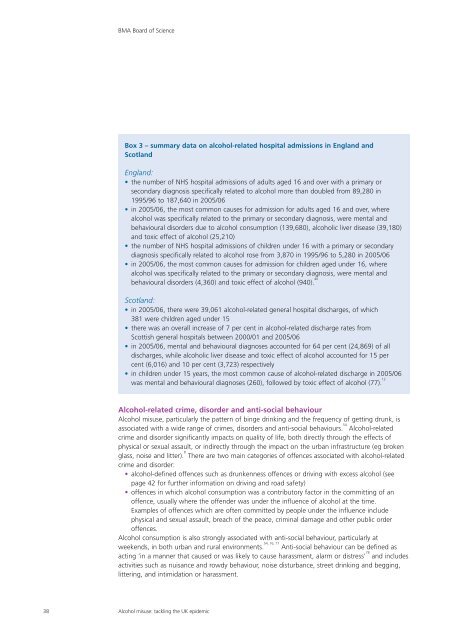Alcohol misuse: tackling the UK epidemic - London
Alcohol misuse: tackling the UK epidemic - London
Alcohol misuse: tackling the UK epidemic - London
Create successful ePaper yourself
Turn your PDF publications into a flip-book with our unique Google optimized e-Paper software.
38<br />
BMA Board of Science<br />
Box 3 – summary data on alcohol-related hospital admissions in England and<br />
Scotland<br />
England:<br />
<strong>the</strong> number of NHS hospital admissions of adults aged 16 and over with a primary or<br />
secondary diagnosis specifically related to alcohol more than doubled from 89,280 in<br />
1995/96 to 187,640 in 2005/06<br />
in 2005/06, <strong>the</strong> most common causes for admission for adults aged 16 and over, where<br />
alcohol was specifically related to <strong>the</strong> primary or secondary diagnosis, were mental and<br />
behavioural disorders due to alcohol consumption (139,680), alcoholic liver disease (39,180)<br />
and toxic effect of alcohol (25,210)<br />
<strong>the</strong> number of NHS hospital admissions of children under 16 with a primary or secondary<br />
diagnosis specifically related to alcohol rose from 3,870 in 1995/96 to 5,280 in 2005/06<br />
in 2005/06, <strong>the</strong> most common causes for admission for children aged under 16, where<br />
alcohol was specifically related to <strong>the</strong> primary or secondary diagnosis, were mental and<br />
behavioural disorders (4,360) and toxic effect of alcohol (940). 40<br />
Scotland:<br />
in 2005/06, <strong>the</strong>re were 39,061 alcohol-related general hospital discharges, of which<br />
381 were children aged under 15<br />
<strong>the</strong>re was an overall increase of 7 per cent in alcohol-related discharge rates from<br />
Scottish general hospitals between 2000/01 and 2005/06<br />
in 2005/06, mental and behavioural diagnoses accounted for 64 per cent (24,869) of all<br />
discharges, while alcoholic liver disease and toxic effect of alcohol accounted for 15 per<br />
cent (6,016) and 10 per cent (3,723) respectively<br />
in children under 15 years, <strong>the</strong> most common cause of alcohol-related discharge in 2005/06<br />
was mental and behavioural diagnoses (260), followed by toxic effect of alcohol (77). 12<br />
<strong>Alcohol</strong>-related crime, disorder and anti-social behaviour<br />
<strong>Alcohol</strong> <strong>misuse</strong>, particularly <strong>the</strong> pattern of binge drinking and <strong>the</strong> frequency of getting drunk, is<br />
associated with a wide range of crimes, disorders and anti-social behaviours. 54<br />
<strong>Alcohol</strong>-related<br />
crime and disorder significantly impacts on quality of life, both directly through <strong>the</strong> effects of<br />
physical or sexual assault, or indirectly through <strong>the</strong> impact on <strong>the</strong> urban infrastructure (eg broken<br />
glass, noise and litter). 8<br />
There are two main categories of offences associated with alcohol-related<br />
crime and disorder:<br />
alcohol-defined offences such as drunkenness offences or driving with excess alcohol (see<br />
page 42 for fur<strong>the</strong>r information on driving and road safety)<br />
offences in which alcohol consumption was a contributory factor in <strong>the</strong> committing of an<br />
offence, usually where <strong>the</strong> offender was under <strong>the</strong> influence of alcohol at <strong>the</strong> time.<br />
Examples of offences which are often committed by people under <strong>the</strong> influence include<br />
physical and sexual assault, breach of <strong>the</strong> peace, criminal damage and o<strong>the</strong>r public order<br />
offences.<br />
<strong>Alcohol</strong> consumption is also strongly associated with anti-social behaviour, particularly at<br />
54, 76, 77<br />
weekends, in both urban and rural environments. Anti-social behaviour can be defined as<br />
acting ‘in a manner that caused or was likely to cause harassment, alarm or distress’ 78<br />
and includes<br />
activities such as nuisance and rowdy behaviour, noise disturbance, street drinking and begging,<br />
littering, and intimidation or harassment.<br />
<strong>Alcohol</strong> <strong>misuse</strong>: <strong>tackling</strong> <strong>the</strong> <strong>UK</strong> <strong>epidemic</strong>
















